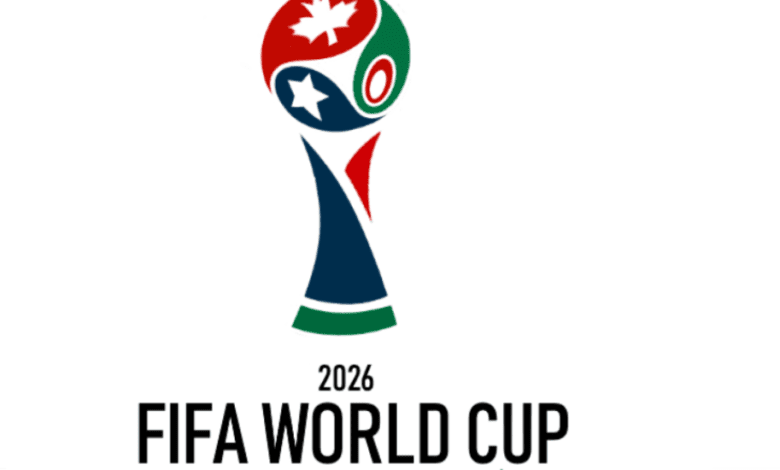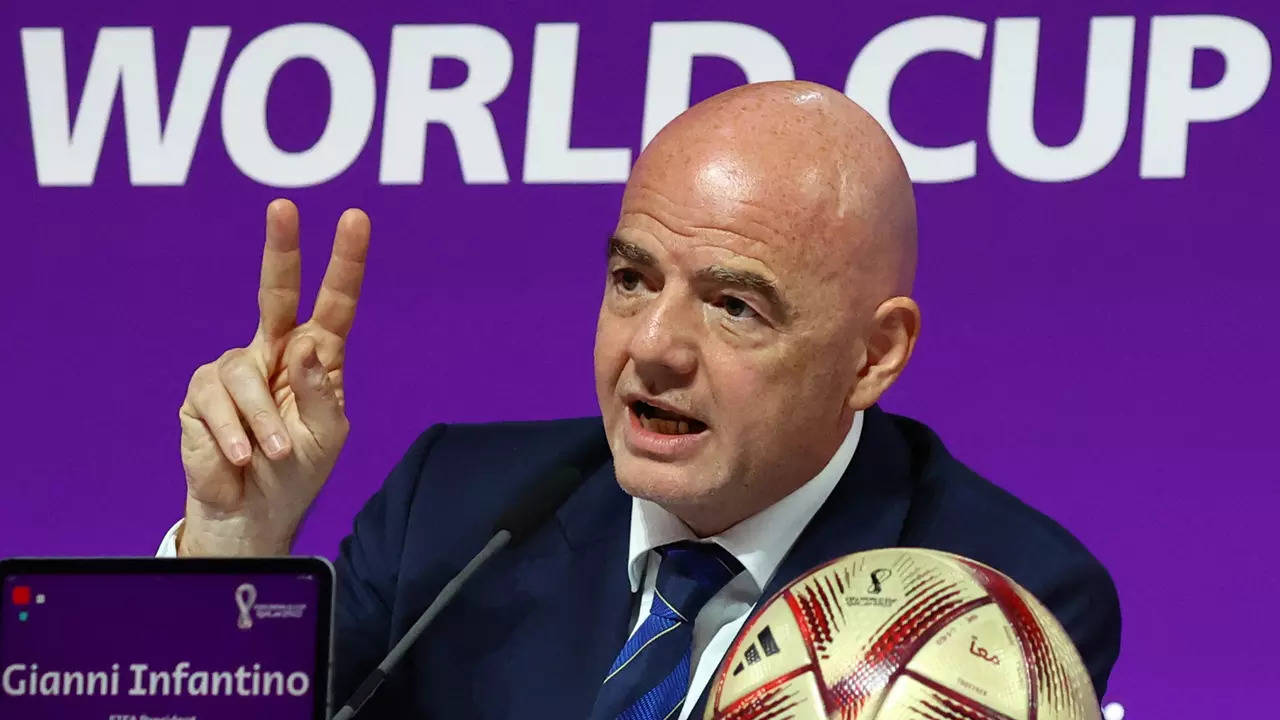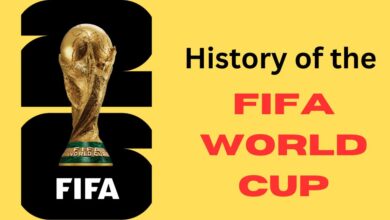FIFA Logo 2026: Unveils Official Logo for 2026 World Cup; Here’s the Design
The logo for the 2026 World Cup has been revealed by FIFA, and here is what it looks like.

FIFA Logo 2026 unveiled
On May 17, 2023, FIFA President Gianni Infantino, a noted figure in the sports world, made a high-profile appearance in Los Angeles, California, to help promote FIFA’s #WeAre26 campaign, which aims to drum up excitement and allyship for the upcoming 2026 World Cup. As part of the campaign, FIFA revealed official branding for the event, including logos for each of the host cities distributed across Canada, Mexico, and the United States.
The 2026 World Cup will pose challenges to numerous players due to six-hour trips and time-zone changes, as stated by FIFA President Gianni Infantino.

On the evening of May 17th (local time) at the renowned Griffith Observatory in Los Angeles, FIFA unveiled the official logo for the highly-anticipated 2026 FIFA World Cup in the United States, Mexico, and Canada, marking the formal initiation of the journey towards the event.
Revealed by FIFA’s current President, Gianni Infantino, along with double World Cup winner Ronaldo Nazário, the logo distinctly displays an accurate representation of the FIFA World Cup trophy as its centrepiece. Along with this eye-catching visual, the year of the tournament is boldly displayed in the background.
This is the first time that the official logo has included the FIFA World Cup Trophy, which is a significant milestone.

You can also see Top 10 Most Watched Sporting Events in USA
In an unprecedented development, the upcoming World Cup tournament will feature an increase in the number of participating teams from 32 to 48, which will be co-hosted by three countries, an additional milestone.
Regarding this progress, Infantino recognized the inevitable difficulties that come with such an agreement. He underscored the practical intricacies that come with holding the competition across a broad continent that covers three significant countries.
The vast distances, different time zones, and varying climate conditions present significant challenges that need to be taken into account. The varying elevations in Mexico and contrasting water levels in other areas add to the complexities.

Given the situation, Infantino emphasized the importance of creating a suitable atmosphere that can guarantee the best conditions for teams and spectators during the competition.
At the revelation of the authorized emblem and branding for the 2026 World Cup, Infantino revealed that in the initial stages of the broadened competition, the teams would be arranged into regional groupings.
The resolution has been reached to ease transportation logistics for the competing squads, taking into account the massive scope of the 2026 championships.
“To reduce travel requirements, particularly in the initial stages, we will establish clusters where teams will be stationed based on the draw. These clusters will serve as the venues for their respective games.”
Top 10 Largest Football Grounds In The World
During a recent meeting in Doha, the 32 coaches who participated in the previous year’s World Cup discussed the possibility of traveling and relocating teams to various regions. This was disclosed by Infantino.
“He mentioned that one of the benefits of the World Cup hosted by Qatar was that players could get some rest and be in bed within an hour after the game,” he explained.
“In 2026, there will be travel required for the teams. However, we will take necessary steps to ensure that the travel will be properly coordinated and the teams’ needs will be met as best as possible.”
Infantino is optimistic that the tournament can capitalize on the achievements of the 1994 World Cup in the USA, which played a crucial role in the establishment of Major League Soccer in North America.
When asked about his hopes for the impact of the 2026 event, Infantino stated that his goal is for soccer to become the most popular sport in North America.
You can also see The Future of Sports: How Technology Will Change the Game at Paris 2024
Infantino’s comments were made during FIFA’s extravagant event at the Griffith Observatory in Los Angeles, where they hosted an exclusive gathering for celebrities and former players. The occasion was organized to reveal the official branding for the upcoming 2026 tournament. In attendance was former US international Alexi Lalas, renowned for his notable performances during the 1994 edition of the tournament.
Lalas supported Infantino’s promise to establish teams in different regions.
“Without sounding too much like a grumpy old man, it’s essential to mention that these individuals are not enduring the discomforts of economy class on a budget airline. In fact, they travel frequently on charter planes,” stated Lalas in an interview with AFP.
“However, it’s essential to consider that the discussion is related to lengthy trips lasting six hours, which also involve changes in time zones. This can significantly impact the nature of the competition for players worldwide. Thus, adopting a regional approach would be a practical solution.”
You can also see Paris 2024 Olympics: The Most Sustainable Olympics Yet
Design Concept
The FIFA Logo for 2026 incorporates a vibrant and dynamic design that draws inspiration from diverse cultures and the overarching theme of unity. The emblem features a harmonious fusion of elements, symbolizing the convergence of nations and their shared passion for football. It reflects the tournament’s core values: teamwork, respect, and fair play.
Central Element
At the heart of the logo lies a stylized football, elegantly adorned with intricate patterns inspired by art forms from different parts of the world. The patterns represent the rich cultural tapestry that football weaves together, acting as a universal language that unites people of all backgrounds. Football serves as a focal point, capturing the attention and imagination of fans worldwide.
Surrounding Elements
Encircling the central football are arcs that represent unity, strength, and collaboration. These arcs seamlessly intertwine, forming a fluid and continuous shape that signifies the interconnectedness of nations and the global nature of the World Cup. The colours chosen for the arcs reflect the diversity of the participating countries, highlighting the vibrant tapestry of cultures that FIFA aims to celebrate.
Typography
The typography used in the FIFA Logo for 2026 is bold and modern, reflecting the dynamic and progressive nature of the tournament. The typeface complements the emblem, harmonizing with its overall design and enhancing the visual impact. The text may include the tournament name, “FIFA World Cup 2026,” and the host country’s name to further emphasize the unique edition.
Conclusion
With the unveiling of the FIFA Logo for 2026, the countdown to the next World Cup has truly begun. The emblem stands as a testament to FIFA’s commitment to inclusivity and unity, promoting the power of football to bring people together from all corners of the globe. As fans eagerly await the tournament, the emblem will serve as a symbol of hope, anticipation, and the extraordinary experiences that lie ahead.


One Comment